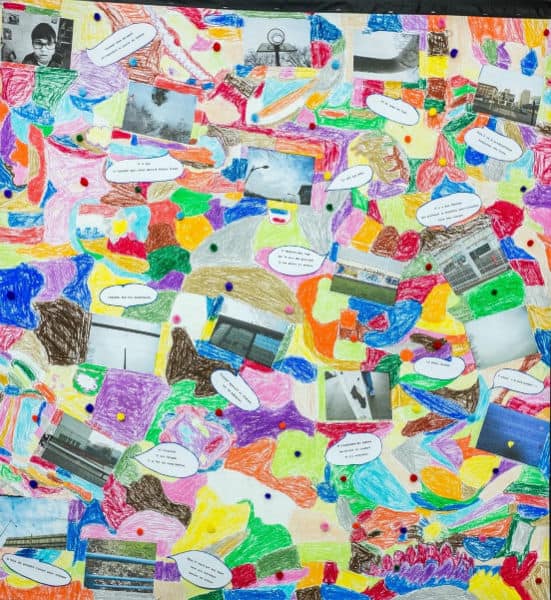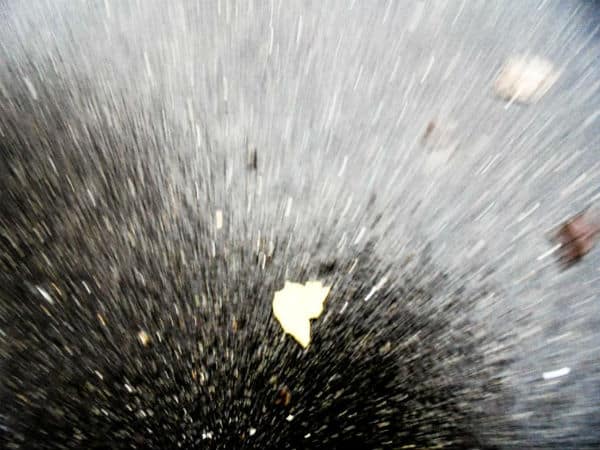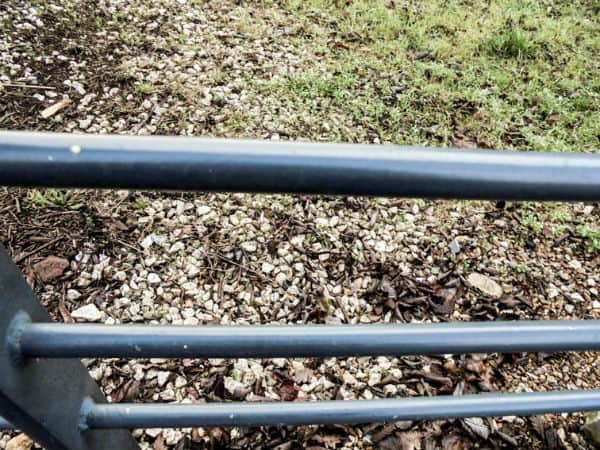In 2014 I started exploring people’s lives in Parisian suburbs (banlieue)[1] through engaged and creative visual practices. Being an independent photographer, I wanted to see how people’s experiences may be depicted through a variety of photographic practices. For me, discovering the way people interact in the city demanded a wider, engaged and creative way of thinking the urban experience than just making a ‘classic’ ethnography.[2] After all, following the same old and structured process of ‘ethnographic data extraction’ would only reproduce the same images and stereotypes I already had about the banlieue.[3]
I started exploring people’s lives with my camera in Sarcelles, the biggest ‘social housing city’ of France.[4]
Photography was a useful instrument to depict through creative and reflexive activities the urban experiences of people.
How should I conceive my photographic practice when working through a participatory framework? What is the status of engagement in my ethnographic practice? Developing participatory methods might be counterproductive in order to understand peoples lives? How should we conceive the role of esthetics and plasticity when working with the participants?
Photography is part of a wider communicational repertoire, in which verbal testimonies, drawings and materials are as important as the graphic content of the photographs. Following this understanding,
in 2016 I started working with a group of 12 students with cognitive disabilities at the Ecole K of Sarcelles, a local elementary school. We explored the narrative dimensions of photography when depicting urban experience through a series of workshops.
In these exercises I studied the way photography may be a useful channel to explore the city through non-descriptive and non-representational narratives of children’s lives and dreams. In particular, I collaborated with the participants to create fictional stories and to depict the visual experience of being and living in Sarcelles.
In this essay I present a recent experience with a group of young students. The idea is to talk about photographic engagement,[5] a set of practices in which photography could be used and seen as a tool for understanding different aspects of people’s lives.
Engagement implies creation and collaboration. Rather than using photography as a means to describe the reality, we employ it as a route to (re)create a particular experience of their life in the city.
The (re)creation of the experience engages a creative, imaginative and non-representational photographic activity.
As a consequence, I adhere to an anthropological praxis which embraces visual materials as a way to discover new ways of thinking, creating and collaborating with people. Tim Ingold (2014, 2013) has widely criticized the assumption of ethnography as a process of ‘data extraction’. Instead, he advocates for new creative and perceptive ways of doing anthropology through ‘materials, movements and lines’. In visual anthropology, Sarah Pink widely developed Ingold’s approaches (2015, 2013, 2006). She advocates for new phenomenological, sensory and collaborative practices in visual ethnography. The main objective of an anthropologist should be the ‘production of knowledge and ways of knowing rather than … the collection of data’ (Pink 2013, 35).
The ‘formula’ – which is usually taught to (under)graduate students – invites the anthropologist to conceive ethnography as an extractive process of data collection. Like a miner, ethnographers should be able to find the ‘gold nugget’, to observe and write people’s actions during longs periods of time. Inductively, the ethnographer recreates the social and cultural structures and patterns of a community. Immersed in a complex and unstructured ecology of moral, cultural and political practices, she or he will elucidate large amounts of ‘ethnographic data’ through rigorous, long-term observational practices.
I decided to take some distance form this classic way of producing anthropological knowledge. Following Ingold and Pink,[6] I advocate for alternative ways of using and conceiving materials in visual anthropology.
If we embrace the idea of photography as a conversational practice (Gunthert 2015), we may explore the multiple ways people develop a discourse based on their own visual experiences.
In that sense, photography may be a useful channel to understand and depict through a creative, embodied and reflexive activity.
Creative engagement
In Dominique’s photo, a functionalist building is being crossed over by an airplane. There are some clouds and all the windows are closed. Dominique used this image to create a fictional story of the city.
He imagined he was traveling, that he was going back to a place he never knew, but he was stopped by the buildings and the fences of the city.
Dominique is a 12 years old boy, living in Sarcelles. The image was captioned by the following text:
‘Dominique aperçoit un drapeau sur un bâtiment,
regarde des fils électriques,
va s’asseoir. Il est fatigué. Il a fait un long chemin.
Il rêve de prendre l’avion pour voyager.
Mais il reste sur son banc face aux barreaux comme en prison.’[7]
(Dominique, Ecole M. Sarcelles)
The text and the photograph is part of a wider creative exercise in which the entire group crafted a collective ‘story of the city’ through drawings, pictures and oral testimonies:
The city is not a fixed reality for them. Creating a narrative of the city implied the development of fictional stories. Instead of describing the city, they used photography in its non-representational dimension to create: most of the images don’t have an ‘index relationship’ (rapport indiciaire) to the subject represented. For instance, the following image does not relate to the act of falling or feeling the rain:
However, its plastic character recreates a sensory feeling of plunge. This photograph was involuntarily made by Fatou. The participants didn’t have the technical training and equipment to control the shutter-speed, the aperture or the sensor sensitivity. However, by chance she produced this image when we were walking through a basketball field. When we saw it, they started playing with the image, they modeled and constructed a particular sense of falling through an active, collective and engaged process of creation:
Il pleut. « Je vais tomber ! »
Il s’approche du poteau du terrain de football et s’y accroche.
(It is raining. « I am going to fall! »
He approaches the soccer goal post and hangs on it.)
The creative engagement allows the photographers to invent and re-create their everyday life experiences. For the group of children, creating a story through a variety of materials was a channel to think reflexively about the sensory dimension of the city.
I wasn’t interested in the documentary dimension of the photographs. Instead, I wanted to discover how they might use the different materials to create something that for them may seem an ‘everyday life experience in the city’.
In that sense, they created a story in which we may find a variety of elements related to the urban experience: first, we may see an interest for the buildings. In Picture 1, the depiction of part of a social housing building (tour HLM) crossed over by an airplane gives them the representational elements to talk about a particular feeling: the act of dreaming. They want to fly but they can’t, they remain on a bench, facing the bars, as if they were in prison.
Sarcelles is the 4th most impoverished city of the country and a significant part of its population has an immigrant background. The city is located not far from the Charles de Gaulle airport and 80% of the inhabitants live in what is called le grand ensemble. In this area most of the buildings are functionalist structures, characterized by holding one of the most diverse populations of France (more than ‘90 communities’ (la ville aux 90 communautés). Dominique took the photographs in this zone, where he lives, near to the Ecole K.
This image concludes the story thought by Dominique.
The bars traverse the frame, the grass and some dead leaves. Dominique dreams to fly but he stays in prison, without a subject, the fences recreate the feeling of being confined. Bars, fences, buildings seem to be part of a greater space that make them feel enclosed.
This visual exercise doesn’t give us ‘visual information’ about the relationship between an impoverished city like Sarcelles, the visual experience of the children and the feeling of confinement. Instead, it explores a deeper dimension of the visual experience: the emotive, sensual and affective relationship existing between the visual elements of an image, the inventiveness of the author(s) and the material elements of the city (fences, buildings, airplane).
As such, photography was used in this case as part of a larger practice of storytelling. It was a creative practice in which the descriptive quality of photography has been less useful than the imaginative practice developed collectively.
In this case, the photographic engagement was based on a narrative practice in which we tried to co-create rather than represent a fixed visual reality.
Conclusion
In this essay I advance the idea that photography may be an empowering tool to re-imagine the experience of people living in marginal cities through creative practices. In particular, I have been exploring children’s experiences through imaginative activities of depiction, embodiment and creation: by crafting a collective story based on a variety of communicational materials such as photographs, drawings and writings, we were able to explore a non-representational activity of ‘being in the city’.
This particular exercise was an opportunity to explore the fictional and narrative dimension of a photography in a research about life experiences in the banlieue. It was part of a larger research project in which I use different materials, approaches and methods to analyze people’s experiences in urban settings. This exercise cannot be perceived as a new and ‘naïve’ way of depicting the city from the viewpoint of an ‘innocent eye’.[8] Instead, it is an exercise of photographic engagement with a group of young students who live and interact in Sarcelles. We tried collectively to depict a personal experience through a practice of discussion and creation: in consequence, one of the photographic engagements we involved was a collective creation of an urban narrative.
‘Et demain? …l’anthropologue n’aura plus le monopole de l’observation, il sera
lui-même observé, enregistré, lui et sa culture. Ainsi le film ethnographique
nous aidera-t-il à «partager» l’anthropologie.’ (Rouch 1979, 71)
[1] Banlieue is a French word to designate the suburbs. It is composed by the words –lieu (place) and ban- (interdiction). The banlieue are the ‘banned places’, socially and politically dismissed by the State. The banlieues are spaces of confinement intersected by economical, cultural and racial forms of inequality (Agier 2015, 30)
[2] i.e. Atkinson (2001).
[3] The banlieue has been largely studied through classic ethnographic approaches i.e. Lepoutre 2008; Kokoreff 2007; Kokoreff and Lapeyronnie 2013.
[4] A city located in the northern suburbs of Paris.
[5] cf. Leon-Quijano, forthcoming
[6] I refer to Ingold and Pink, but there is a variety of authors who had already discussed the alternative ways of doing visual and sensory ethnography: Cox, Irving, and Wright 2015; Irving 2007; Grimshaw and Ravetz 2005; Taylor 1996; MacDougall 2005; Rouch 1979; Stoller 1997; Gómez Cruz 2012; Grasseni 2007; Hogan and Pink 2010; Fors, Bäckström, and Pink 2013.
[7] Translation. ‘Dominique sees a flag on a building,
He looks at the electrical wires,
He sits down. He is tired. It has come a long way.
He dreams of taking an airplane and travelling.
But he remains on his bench facing the bars, like in a prison.’
[8] For critical approaches on participatory photography with children cf. Fattal ‘fetishistic talk of a child’s innocent eye’ (2016, 41) and Kofod-Svenson (forthcoming).
References
Agier, Michel. 2015. Anthropologie de La Ville. 1re édition. Paris: Puf.
Atkinson, Paul, ed. 2001. Handbook of Ethnography. London ; Thousand Oaks: SAGE.
Cox, Rupert, Andrew Irving, and Christopher Wright. 2015. Beyond Text : Critical Practices and Sensory Anthropology. Manchester: Manchester University Press.
Fattal, Alex. 2016. Participatory Realism: Photographing the Precarity and Resilience of Childhood in South Africa. Transition, no. 121: 40–48.
Fors, Vaike, Åsa Bäckström, and Sarah Pink. 2013. Multisensory Emplaced Learning: Resituating Situated Learning in a Moving World. Mind, Culture, and Activity 20 (2): 170–83. doi:10.1080/10749039.2012.719991.
Gómez Cruz, Edgar. 2012. De la cultura Kodak a la imagen en red: una etnografía sobre fotografía digital. UOC. Barcelona.
Grasseni, Cristina, ed. 2007. Skilled Visions: Between Apprenticeship and Standards. EASA Series, [v.] 6. New York: Berghahn Books.
Grimshaw, Anna, and Amanda Ravetz. 2005. Visualizing Anthropology. Bristol, UK; Portland, OR: Intellect.
Gunthert, André. 2015. L’image Partagée: La Photographie Numérique. L’écriture Photographique. Paris: Textuel.
Hogan, Susan, and Sarah Pink. 2010. Routes to Interiorities: Art Therapy and Knowing in Anthropology. Visual Anthropology 23 (2): 158–74.
Ingold, Tim. 2013. Making: Anthropology, Archaeology, Art and Architecture. London: Routledge.
———. 2014. That’s Enough about Ethnography! HAU: Journal of Ethnographic Theory 4 (1): 383. doi:10.14318/hau4.1.021.
Irving, Andrew. 2007. Ethnography, Art, and Death. Journal of the Royal Anthropological Institute 13 (1): 185–208.
Kofod-Svenson, Marie. (Forthcoming). Framing a Story of Possibilities: The Subjunctive Mood of a Participatory Photography Project in San Diego, United States. Visual Ethnography
Kokoreff, Michel. 2007. Du stigmate au ghetto. Informations sociales, Informations sociales, 141 (5): 86–95.
Kokoreff, Michel, and Didier Lapeyronnie. 2013. Refaire la cité : L’avenir des banlieues. Paris: Seuil.
Leon-Quijano, Camilo. (forthcoming). L’engagement Photographique : L’expérience Dans La Création D’un Récit Urbain. In « Terrains », Engagements Citoyens et Co-Créations Artistiques (titre Provisoire).
Lepoutre, David. 2008. Coeur de banlieue: codes, rites et langages. Poches Odile Jacob 70. Paris: Jacob.
MacDougall, David. 2005. The Corporeal Image – Film, Ethnography, and the Senses. Princeton, N.J.: Princeton University Press.
Pink, Sarah. 2006. The Future of Visual Anthropology: Engaging the Senses. London ; New York: Routledge.
———. 2013. Doing Visual Ethnography. 3rd Revised edition. Los Angeles: SAGE Publications Ltd.
———. 2015. Doing Sensory Ethnography. 2. ed. Los Angeles: Sage.
Rouch, Jean. 1979. La Caméra et Les Hommes. In Pour Une Anthropologie Visuelle, edited by Claudine De France, 53–71. Cahiers de L’homme, N.S., 19. Paris: Mouton.
Stoller, Paul. 1997. Sensuous Scholarship. Contemporary Ethnography. Philadelphia: University of Pennsylvania Press.
Taylor, Lucien. 1996. Iconophobia. Transition, no. 69: 64–88.








